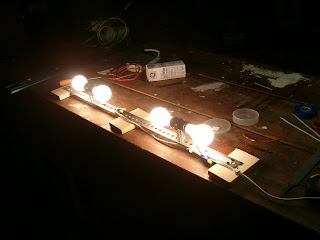This is four 75-watt incandescent bulbs. Saving energy here is exactly not the point. I made sure that the wide blade on the two-prong plug, which is neutral and identified on the extension cord wire by rough striations, is connected to the white wire of the double receptacles. This means the collar of the receptacles is neutral and the button at the bottom is hot. That's what you do; I read it on the internet. It's because the black/hot/narrow blade needs to be where you're least likely to run afoul of it, like when changing a light bulb while the lamp is still on.
I brought the heat box out into the driveway and ran an extension cord there as well. The chair that is holding up the door is for sitting in while I wait for nothing to happen:
The lamp assembly is just visible on the left side of the floor of the heat box. I fashioned the door, as planned, from two pieces of bad hardboard laminated together with spray adhesive. To that I attached two of the three aluminized bubble wrap insulation sheets by going around the perimeter with the heavy aluminum reflective tape. The third sheet I attached using the reflective tape as double-stick, folded in half the long way. This makes the third sheet a gasket that is puffy right to the edge; the first two sheets are mashed down by their connection to the hardboard. The hinge is more aluminum tape. It doesn't have to be good for a lot of cycles.
On this 73F sunny day the heat box went from ambient at 11:25AM to 180F at 11:42AM. The picture shows it a little lower because I'd unplugged the lamps 20 seconds prior, and I had not taped the door shut all the way around to make a tight seal (light was showing where the cord went in). This setup appears to have very little heat retention ability, but I am very happy with the result. There was no sign of overheating of the materials, the outside of the box felt comfortable to the touch, the wiring is solid, and I easily hit the target temperature of 160F.
Good day so far, I think. Next, I'm either going to:
- do a practice lamination and cure of a small basswood and fiberglass sandwich, or
- just dive right in, go nuts, and see what happens



Glad to see the test went well.
ReplyDeleteWould 3 bulbs, always on, work better? Or do they fail to reach the desired operating temp?
I dunno. Time-to-temperature is like 25 minutes so experimenting would take a long time. A vent hole with a sliding door would make sense too.
ReplyDelete25 minutes to warm up is long enough. I guess a thermocouple is what you need. But obviously, there's no rush to get one. Maybe when you start churning these things out on a regular basis. :)
ReplyDelete